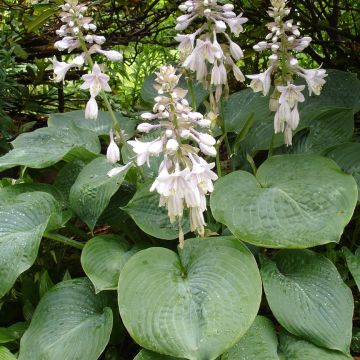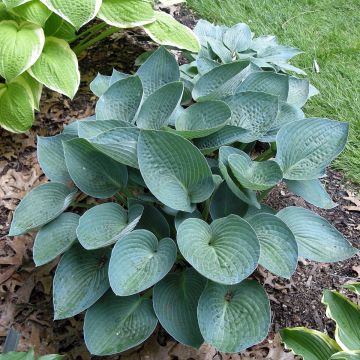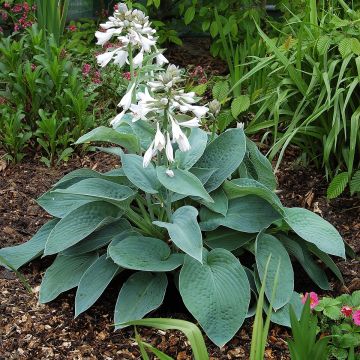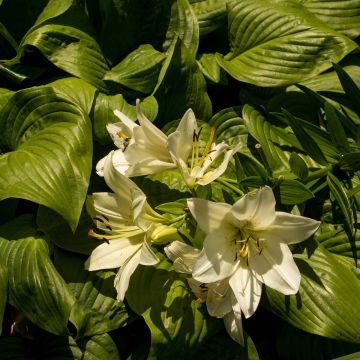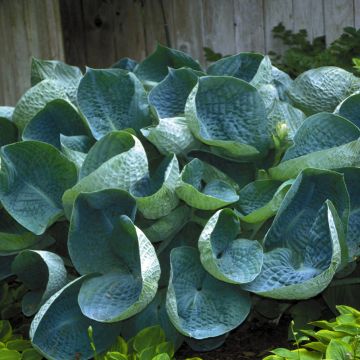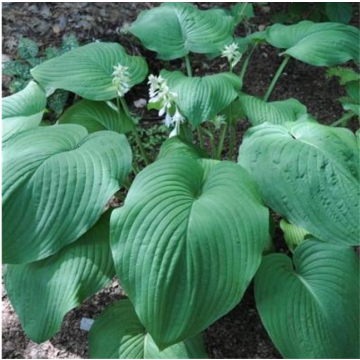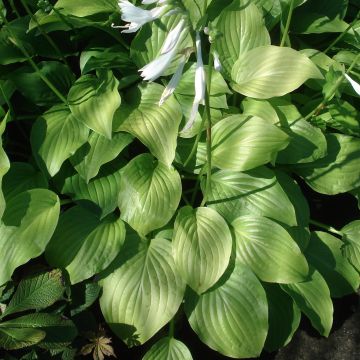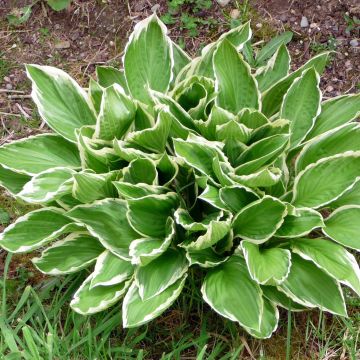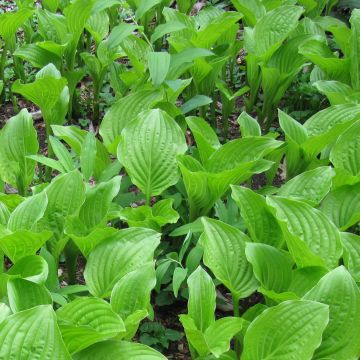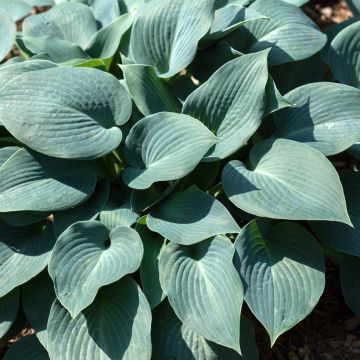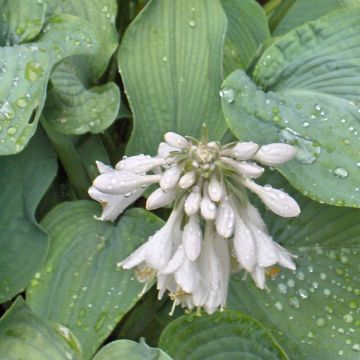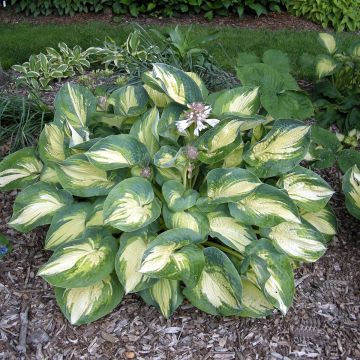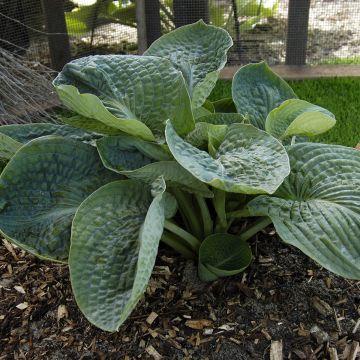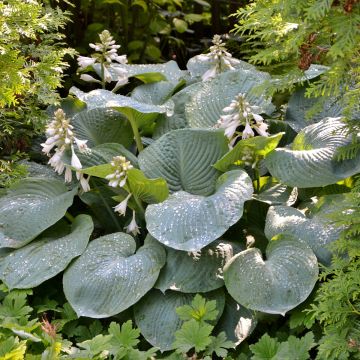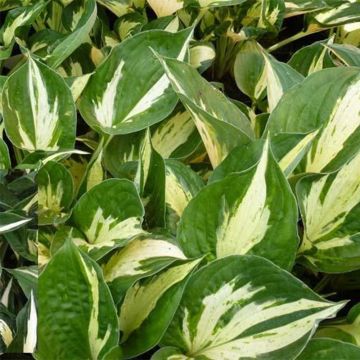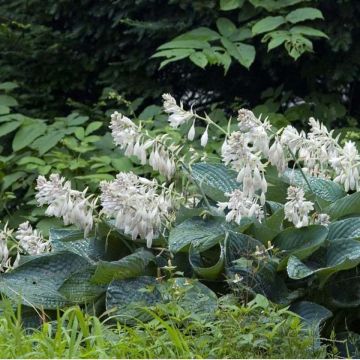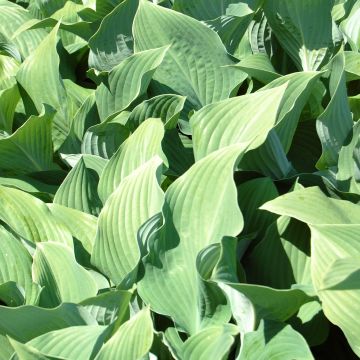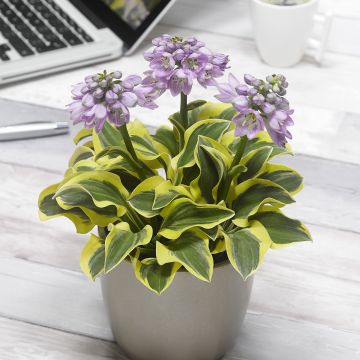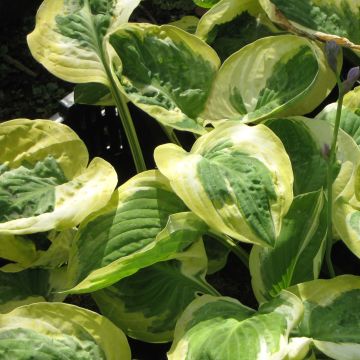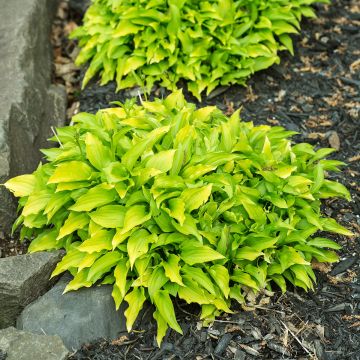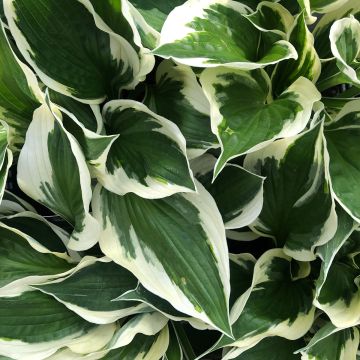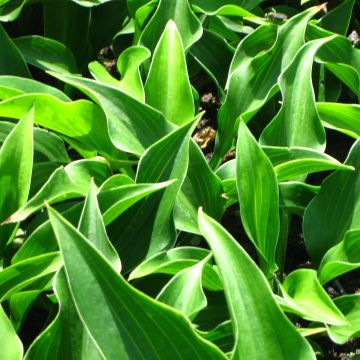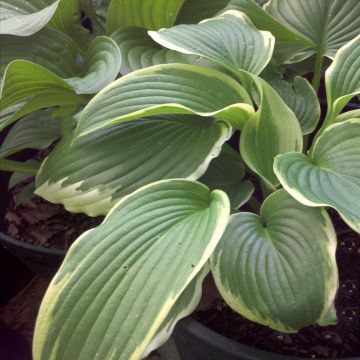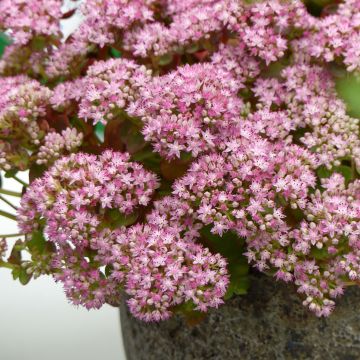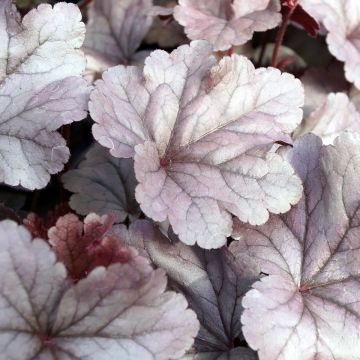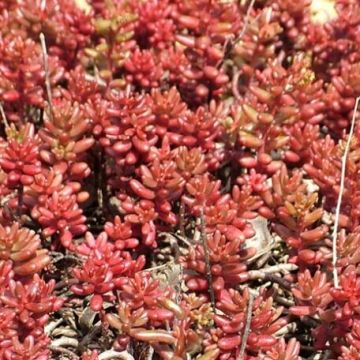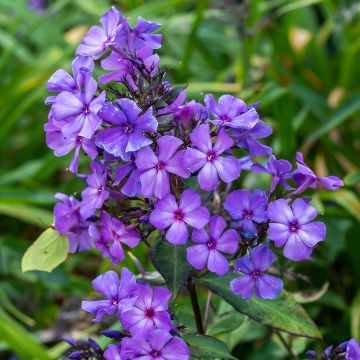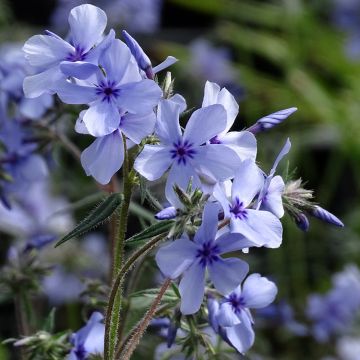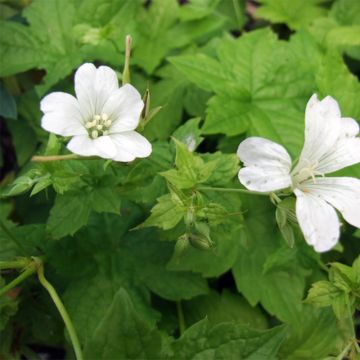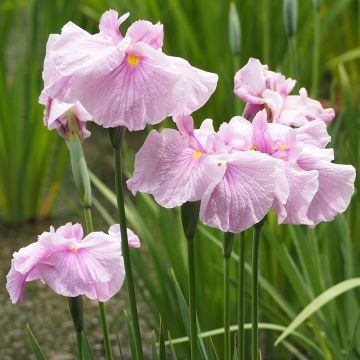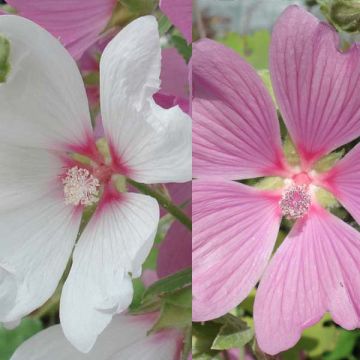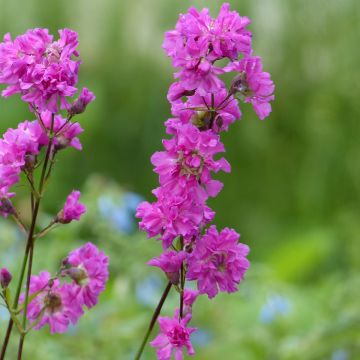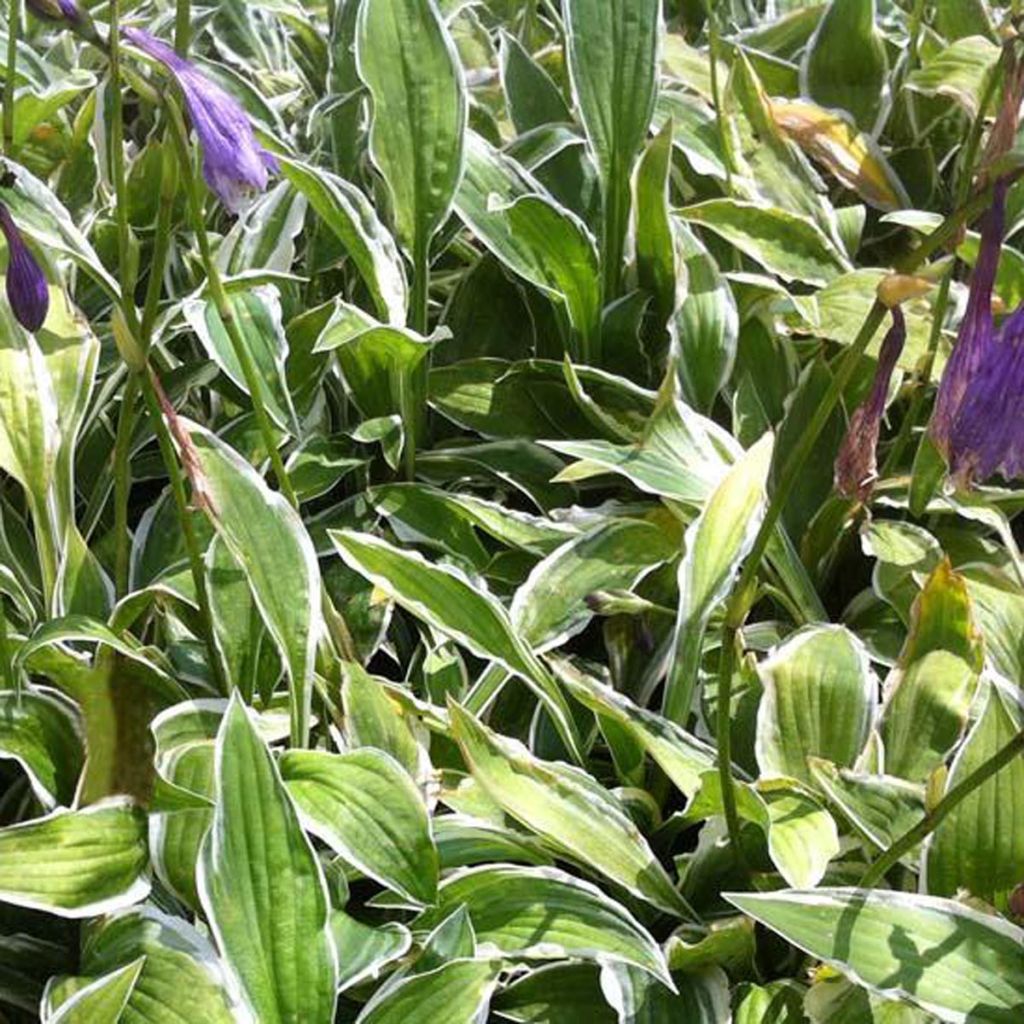

Hosta nigrescens Krossa Cream Edge
Hosta nigrescens Krossa Cream Edge
Hosta nigrescens Krossa Cream Edge
Black Plantain Lily, Funkia
Why not try an alternative variety in stock?
View all →This plant carries a 12 months recovery warranty
More information
We guarantee the quality of our plants for a full growing cycle, and will replace at our expense any plant that fails to recover under normal climatic and planting conditions.
From €5.90 for pickup delivery and €6.90 for home delivery
Express home delivery from €8.90.
Does this plant fit my garden?
Set up your Plantfit profile →
Description
Hosta nigrescens 'Krossa Cream Edge', also known as Funkia, is a small hybrid variety with narrow, veined leaves of medium green, marginated with white. It produces spikes of white to light lavender flowers in July and August. Easy to grow and thrive in moist soil, it will do well in large pots or containers, can make an excellent ground cover, and will add an exotic touch to pond edges.
The hybrid Hosta 'Krossa Cream Edge' is a deciduous perennial, forming wide clumps from spring onwards. It belongs to the Asparagaceae family. It is one of the many hybrids obtained from species native to Japan (Hosta nigrescens) and China. The plant reaches a height of 30cm (12in) for the foliage and spreads up to 50cm (20in). This small hosta forms a broad clump, wider than it is tall. It is a long-lived plant with heart-shaped, narrow, medium-green deciduous leaves, with visible veins. The leaves are entirely marginated with white. The flowering occurs in July-August, with pale lavender to white, pendulous bell-shaped flowers clustered towards the top of the peduncles, which can reach a height of 50cm (20in). This perennial spreads through stolons, similar to strawberries.
The hybrid Hosta 'Krossa Cream Edge' pairs well with partial shade, helxine, ferns, and eucomis, creating an elegant and surprising effect with minimal maintenance. This hosta will also thrive alongside columbines, tall foxgloves, or small violets. All hostas grow well in pots and can remain in the same container for several years. Choose a special geranium potting soil to use during the growing season. As long as the foliage is not too dense, watering from the top of the pot is possible. Then place a saucer under the pot and pour water into it, maintaining a constant level in summer.
Most species commonly found in Western gardens were introduced from Japan to Europe by Philipp Franz von Siebold in the mid-19th century. Hostas are edible and are called "urui" in Japan, where they are commonly consumed in various forms.
Report an error about the product description
Flowering
Foliage
Plant habit
Botanical data
Hosta
nigrescens
Krossa Cream Edge
Liliaceae - Hostaceae
Black Plantain Lily, Funkia
Cultivar or hybrid
Other Hostas - Plantain Lilies
Planting and care
Hostas are planted in spring or autumn. Hostas prefer a deep, fertile, humus-rich, loose soil, preferably neutral to acidic (at least low in limestone), and moist to wet throughout the year. Plant them in partial shade or dappled shade and in a sheltered location away from strong winds.
Prepare a planting hole of 20cm (8in) x 20cm (8in) x 20cm (8in). If your soil is heavy, mix half compost with crumbled soil, partially backfill the hole, and place your potted plant so that the top of the root ball is covered with 3cm (1in) of soil. The addition of a slow-release fertilizer such as bonemeal will nourish your plant during its rooting period without the risk of burning it. Ensure that the collar is well above ground level. Firm the soil and water generously to eliminate air pockets. If the weather is dry, regular watering for a few weeks will aid the establishment of your plant. Also, water regularly during dry summers.
With their common preference for moist places, slugs and snails never stray far from hostas. Even though blue or variegated hostas often have thicker and tougher foliage, which is less appealing to slugs, these plants must be protected from gastropods. Protect your Hostas by surrounding them with ferramol-based pellets (approved for Organic Agriculture), eggshells, coffee grounds, mulch, or any dry and rough natural substance that repels them. Hedgehogs are the gardener's best allies in the fight against gastropods, as unlike chickens, they do not till the soil or attack the lush green shoots of young plants. Finally, some plants have a repulsive odour for slugs, such as wormwood and garlic.
Planting period
Intended location
Care
This item has not been reviewed yet - be the first to leave a review about it.
Summer flowering perennials
Haven't found what you were looking for?
Hardiness is the lowest winter temperature a plant can endure without suffering serious damage or even dying. However, hardiness is affected by location (a sheltered area, such as a patio), protection (winter cover) and soil type (hardiness is improved by well-drained soil).

Photo Sharing Terms & Conditions
In order to encourage gardeners to interact and share their experiences, Promesse de fleurs offers various media enabling content to be uploaded onto its Site - in particular via the ‘Photo sharing’ module.
The User agrees to refrain from:
- Posting any content that is illegal, prejudicial, insulting, racist, inciteful to hatred, revisionist, contrary to public decency, that infringes on privacy or on the privacy rights of third parties, in particular the publicity rights of persons and goods, intellectual property rights, or the right to privacy.
- Submitting content on behalf of a third party;
- Impersonate the identity of a third party and/or publish any personal information about a third party;
In general, the User undertakes to refrain from any unethical behaviour.
All Content (in particular text, comments, files, images, photos, videos, creative works, etc.), which may be subject to property or intellectual property rights, image or other private rights, shall remain the property of the User, subject to the limited rights granted by the terms of the licence granted by Promesse de fleurs as stated below. Users are at liberty to publish or not to publish such Content on the Site, notably via the ‘Photo Sharing’ facility, and accept that this Content shall be made public and freely accessible, notably on the Internet.
Users further acknowledge, undertake to have ,and guarantee that they hold all necessary rights and permissions to publish such material on the Site, in particular with regard to the legislation in force pertaining to any privacy, property, intellectual property, image, or contractual rights, or rights of any other nature. By publishing such Content on the Site, Users acknowledge accepting full liability as publishers of the Content within the meaning of the law, and grant Promesse de fleurs, free of charge, an inclusive, worldwide licence for the said Content for the entire duration of its publication, including all reproduction, representation, up/downloading, displaying, performing, transmission, and storage rights.
Users also grant permission for their name to be linked to the Content and accept that this link may not always be made available.
By engaging in posting material, Users consent to their Content becoming automatically accessible on the Internet, in particular on other sites and/or blogs and/or web pages of the Promesse de fleurs site, including in particular social pages and the Promesse de fleurs catalogue.
Users may secure the removal of entrusted content free of charge by issuing a simple request via our contact form.
The flowering period indicated on our website applies to countries and regions located in USDA zone 8 (France, the United Kingdom, Ireland, the Netherlands, etc.)
It will vary according to where you live:
- In zones 9 to 10 (Italy, Spain, Greece, etc.), flowering will occur about 2 to 4 weeks earlier.
- In zones 6 to 7 (Germany, Poland, Slovenia, and lower mountainous regions), flowering will be delayed by 2 to 3 weeks.
- In zone 5 (Central Europe, Scandinavia), blooming will be delayed by 3 to 5 weeks.
In temperate climates, pruning of spring-flowering shrubs (forsythia, spireas, etc.) should be done just after flowering.
Pruning of summer-flowering shrubs (Indian Lilac, Perovskia, etc.) can be done in winter or spring.
In cold regions as well as with frost-sensitive plants, avoid pruning too early when severe frosts may still occur.
The planting period indicated on our website applies to countries and regions located in USDA zone 8 (France, United Kingdom, Ireland, Netherlands).
It will vary according to where you live:
- In Mediterranean zones (Marseille, Madrid, Milan, etc.), autumn and winter are the best planting periods.
- In continental zones (Strasbourg, Munich, Vienna, etc.), delay planting by 2 to 3 weeks in spring and bring it forward by 2 to 4 weeks in autumn.
- In mountainous regions (the Alps, Pyrenees, Carpathians, etc.), it is best to plant in late spring (May-June) or late summer (August-September).
The harvesting period indicated on our website applies to countries and regions in USDA zone 8 (France, England, Ireland, the Netherlands).
In colder areas (Scandinavia, Poland, Austria...) fruit and vegetable harvests are likely to be delayed by 3-4 weeks.
In warmer areas (Italy, Spain, Greece, etc.), harvesting will probably take place earlier, depending on weather conditions.
The sowing periods indicated on our website apply to countries and regions within USDA Zone 8 (France, UK, Ireland, Netherlands).
In colder areas (Scandinavia, Poland, Austria...), delay any outdoor sowing by 3-4 weeks, or sow under glass.
In warmer climes (Italy, Spain, Greece, etc.), bring outdoor sowing forward by a few weeks.

































